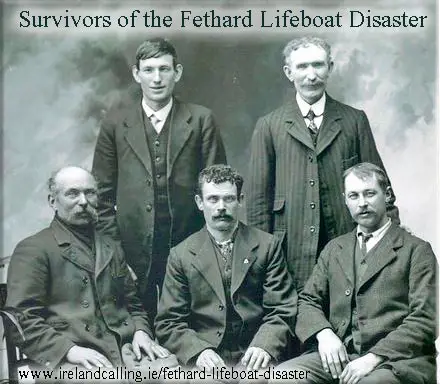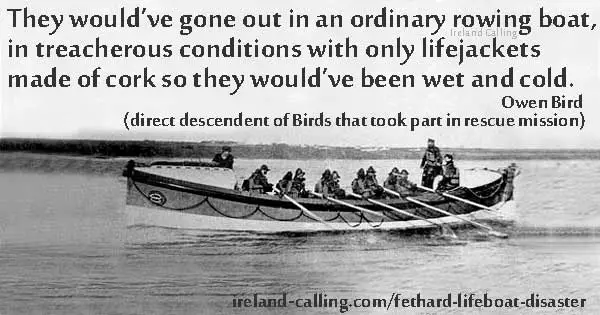On 20th February 1914, nine Irishmen and two Norwegians died off the coast of Wexford in a failed rescue mission that became known as the Fethard Lifeboat Disaster.
A Norwegian crew of ten men were on board their boat, The Mexico, on a journey to deliver timber to Liverpool. However, they got into difficulty in rough seas and swirling rain.
The boat was spotted from the shore by Fethard man Bill Banville who sounded the alarm. Within minutes, 14 members of the lifeboat crew were heading out on the Helen Blake lifeboat to rescue the ten Norwegian sailors on board.
Despite being the one that raised the alarm, Banville was late arriving to the lifeboat and headed out to sea without time to put on a lifejacket.
The lifeboat was struck by a huge wave
The lifeboat battled against the stormy conditions, with wind and rain and crashing waves. Tragically, less than one hour after being launched, it was struck by a huge wave and smashed onto the rocks. The boat was destroyed and many of the men aboard suffered severe injuries.
Nine were unable to fight against the waves and drowned.
The other five managed to gather on one of the tiny islands of Keeragh, along with eight of the Norwegian men who made it out of the water. The group were stranded in the freezing conditions with no food or water.
One of the Norwegian men, 21-year-old Antonio De la Cuna died of hypothermia. The others dug a makeshift grave for his body and continued to huddle together and hang on.
Extreme weather scuppered several rescue attempts
A group of local men tried to drag the boat to shore but were unable to battle against the storm.
The residents of Fethard watched the men’s struggle with a brass telescope as they tried to identify how many, and who had survived.
Three lifeboats were sent to rescue the men, but the weather conditions were so extreme that no boats could get within 300 metres of the small island.
Eventually, after spending three days trapped on the island with no food, water or shelter, the weather relented enough for the men to be rescued.

Bravery of men is a great source of pride for Fethard
A book describing the disaster called The Awful Tragedy of the Helen Blake Lifeboat was written years later by Irish author Liam Ryan.
The tragedy left a marked impression on Fethard. The bravery of the men to risk and ultimately lose their lives in order to save another is a great source of pride for the town.
However, the stories of the horrific way many of the men died, also cause sadness.
Bill Banville’s body was damaged so badly damaged by the rocks that he could only be identified by his boots and the unique way they had been repaired.
One of the survivors said in an interview afterwards, that the sea was almost red with blood.
Man inspired by his ancestors to join lifeboat crew
Richard Bird was part of the rescue team that night. His cousin William and uncle both perished in the sea but he survived. However, his spine was so badly damaged in the accident that his quality of life was poor and he was in constant pain. He died from his injuries less than two years later aged 24.
Owen Bird is a direct descendent of the Birds that took part in the rescue mission. He became a member of the Fethard lifeboat crew today, after being inspired by the bravery of his family members.
He was interviewed by RTÉ about the conditions the men would’ve faced as they headed out to sea:
“It would be hard for us to imagine because they would’ve gone out in an ordinary rowing boat, in treacherous conditions. It would’ve been sleet showers they would’ve been cold and wet.
“They would’ve only had lifejackets made from cork so they would’ve been wet and cold from the start of the service. So it’s completely different it couldn’t compare what would happen today with what happened 100 years ago.”
Irish sporting legend pays tribute to ‘real heroes of our little country’
